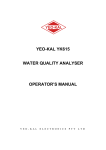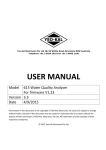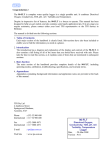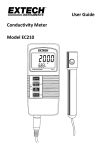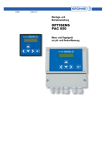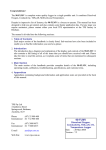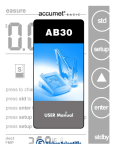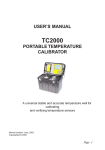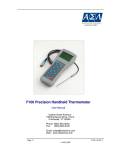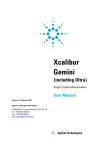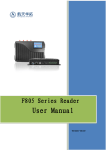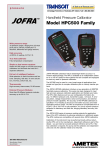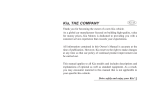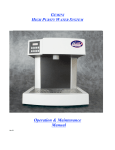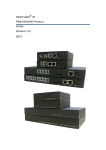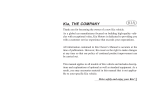Download Model 611 User Manual
Transcript
YEO-KAL YEO-KAL YK611 WATER QUALITY ANALYSER OPERATOR’S MANUAL Y E O - K A L E L E C T R O N I C S P T Y L T D © 2002 YEO-KAL Electronics Pty Ltd, Unit 18/26 Wattle St, Brookvale,NSW,2100, Australia Information in this document is the copyright of YEO-KAL Electronics Pty Ltd and is subject to change without notice. No part of this document may be copied or reproduced by any means without the express written permission of YEO-KAL Electronics Pty Ltd. All trademarks are the property of their respective companies. Revision 2D 1 CONTENTS 1. INTRODUCTION ........................................................................................ 1 1.1 GENERAL DESCRIPTION ............................................................................... 1 1.2 SPECIFICATIONS .......................................................................................... 1 1.2.1 Reader Unit: ........................................................................................... 1 1.2.2 Sensors ................................................................................................... 2 1.3 DESCRIPTION OF READER UNIT ................................................................... 5 1.3.1 Connector Pins ....................................................................................... 5 1.4 DESCRIPTION OF PROBE .............................................................................. 7 1.4.1 Temperature Sensor ............................................................................... 8 1.4.2 Dissolved Oxygen Sensor ...................................................................... 9 1.4.3 Conductivity Sensor ............................................................................... 9 1.4.4 Turbidity Sensor................................................................................... 10 1.4.5 PH/ORP Sensor ................................................................................... 10 2. ASSEMBLY ................................................................................................ 11 2.1 CONNECTING THE PROBE ASSEMBLY ........................................................ 11 2.2 CONNECTING AN EXTERNAL POWER SUPPLY ............................................ 11 3. OPERATION .............................................................................................. 12 3.1 OPERATING INSTRUCTIONS ........................................................................ 12 3.2 ALTITUDE AND SALINITY CORRECTIONS. .................................................. 14 3.3 DISPLAY CONTRAST .................................................................................. 14 3.4 USING THE READER UNIT MEMORY .......................................................... 14 3.4.1 Programming the Reader Unit ............................................................. 15 3.4.2 Clearing Reader Unit Memory. ............................................................ 16 3.5 DOWN LOADING DATA.............................................................................. 17 3.6 DATA PORT OFF/ON ................................................................................ 18 4. CALIBRATION ......................................................................................... 19 4.1 4.2 4.3 4.4 4.5 4.6 4.7 4.8 5. TEMPERATURE CALIBRATION .................................................................... 21 HIGH CONDUCTIVITY/SALINITY CALIBRATION .......................................... 22 LOW CONDUCTIVITY CALIBRATION ........................................................... 23 DISSOLVED OXYGEN CALIBRATION ........................................................... 23 PH CALIBRATION ...................................................................................... 24 ORP CALIBRATION ................................................................................... 25 TURBIDITY CALIBRATION .......................................................................... 26 DEPTH CALIBRATION ................................................................................. 26 MAINTENANCE ....................................................................................... 28 5.1 READER UNIT MAINTENANCE ................................................................... 28 5.1.1 Reset..................................................................................................... 28 5.1.2 Battery Replacement ............................................................................ 28 2 5.2 D.O. SENSOR MAINTENANCE .................................................................... 29 5.2.1 Changing the Membrane ...................................................................... 30 5.2.2 Dissolved Oxygen Stirrer Maintenance ............................................... 31 5.3 PH/ORP SENSOR MAINTENANCE .............................................................. 31 5.4 TURBIDITY SENSOR MAINTENANCE .......................................................... 33 5.5 CONDUCTIVITY SENSOR MAINTENANCE ................................................... 33 6. STORAGE .................................................................................................. 35 7. APPENDIX 1 - CONVERSIONS USED ................................................ 36 8. APPENDIX 2 - COMPLIANCE ............................................................. 37 9. APPENDIX 3 - PART NUMBERS ......................................................... 38 3 Chapter 1 Introduction 1. Introduction The YK611 comes already assembled. The only construction required is to connect the probe assembly to the reader unit and, if necessary, connect the external power supply. 1.1 General Description The YK611 Water Quality Analyser is a robust multi-parameter field instrument which can be used for real time water quality measurements or for remote operation using a built in data logger. The instrument consists of a multi-sensor probe and a reader unit which can both store and display the data. The probe and reader unit have been designed to be compact, light weight and easy to use. Data is transferred to the reader unit using serial communications giving reliable, interference free measurements. The reader unit controls the operation of the instrument, provides easy access to the data, control, memory and calibration functions. The reader unit contains a real time clock and all stored data includes the date and time of measurement. Both stored data and calibration information can be easily down loaded to a computer using the YEO-KAL data transfer programs. The YK611 comes with an auxiliary battery lead (optional) for connecting the instrument to an external power supply during extended periods of remote logging and a storage container to protect the sensors while the instrument is in storage. 1.2 Specifications 1.2.1 Reader Unit: Display: Two lines 16 character alphanumeric LCD. Memory: Remote logging - 2135 samples. Real time (store) 600 samples. All samples include date and time. Memory is backed up by lithium battery to guard against main battery failure. Sample Rate: 1 per 2 minutes to 1 per day in Standard Logging Mode 1 per second in Fast Logging Mode Display update, 2 seconds Communications: Baud rate 4800, 8 data bits, 0 parity, 2 stop bits. 1 Chapter 1 Introduction Power: Battery pack containing 8 "C" size cells. Memory backup voltage supplied by ½ AA lithium cell. Case: Impact resistance polycarbonate; waterproof display, keypad, connectors and case. Dimensions: 130 mm x 95 mm x 190 mm Weight: 1.6 kg 1.2.2 Sensors Temperature Range: -2 - 50ºC Accuracy: ±0.05ºC Resolution: 0.01ºC Type: pt 100 platinum element Conductivity High Range: 0 - 80 ms/cm Accuracy: ±0.05 ms/cm Resolution: 0.02 ms/cm Low Range: 0-8000 us/cm Accuracy: ±5 us/cm Resolution: 3 us/cm Type: Four electrode cell Salinity Range: 0 - 60 ppt Accuracy: ±0.05 ppt Resolution: 0.02 ppt Type: See Appendix 1 - Conversions Used Dissolved Oxygen Range: 0 - 200% saturation 0 - 20 mg/l 2 Chapter 1 Introduction Accuracy: ±0.5% Resolution: 0.1% Type: Active silver and lead electrode sensor with PTFE* membrane and built-in stirrer Turbidity Range: 0 - 600 ntu Accuracy: ±0.5 ntu (0 - 300 ntu range) ±5 ntu (300 - 600 ntu range) Resolution: 0.3 ntu Type: Nephelometric measurement from a 90 sensor with pulsed infra-red light source pH Range: 0 - 14 Accuracy: ±0.03 Resolution: 0.01 Type: Combination silver/silver chloride type with sintered Teflon* junction ORP Range: -700 mV to +1100 mV Accuracy: ±3 mV Resolution: 1 mV Type: Combination bare metal electrode common reference junction with pH electrode (see Appendix 1 - Conversions Used) Depth (optional) Range: 0 - 100 m or 0 - 150 m Accuracy: ±0.5% of full scale Resolution: 0.1 m Type: Dual active silicone strain gauge 3 Chapter 1 Introduction Cable length: 3 m or 10 m. Other lengths made to order. Dimensions: 50 mm diameter, 320 mm long 4 Chapter 1 Introduction 1.3 Description of Reader Unit The reader unit is housed in a tough, durable, high impact polycarbonate case with a keypad and alpha-numeric display mounted on the front panel. The side of the case has three connectors. The top connector is used for data output, the second for connecting an external power supply and the third is the sensor connector. Each connector is provided with a protective cap which screws over the connector. The connectors also have a polarising pin so that incorrect connection cannot be made. Inside the reader unit a CPU controls the operation of the instrument, memory stores data and 8 C size alkaline batteries power the instrument. 1.3.1 Connector Pins The connector pins on the reader unit connectors are numbered in clockwise order from the polarising pin (see figure 1). The following table lists the purpose of each pin on the connectors. Communications Auxiliary Power Sensor Pin 1 Ground Negative Ground Pin 2 RS232 out Positive Data Pin 3 RS232 in not used +12V 5 Chapter 1 Introduction Figure 1: Reader unit for the YK611 and Turo T611 a) Top view showing key pad and alphanumeric display b) End view showing connectors. 6 Chapter 1 Introduction 1.4 Description of Probe The probe assembly consists of sensor, cable and connectors. The body of the probe is made of PVC with a PVC sensor guard. The interface cable is permanently connected to the probe body to eliminate the need for underwater connectors. In the event of the cable being cut, the probe has a waterproof seal between the cable connection and the electronics package. At the other end of the cable is a corrosion and water resistant connector for attaching the assembly to the reader unit. The sensors can easily be accessed by sliding the sensor guard up and Figure 2: a) Complete probe assembly b) Sensor cluster exposed by lifting sensor cage and rotating probe base C) Expanded view of sensor cluster with dissolved oxygen sensor detached. 7 Chapter 1 Introduction rotating the bottom section of the probe. (see fig 2b) The conductivity and dissolved oxygen sensors can be removed for servicing. However, the whole unit must be thoroughly dry before these sensors are removed. A cotton bud can be used to dry the spaces in between the sensors. Figure 3: End view of probe (without bottom section) showing position of sensors. 1.4.1 Temperature Sensor The temperature sensor consists of a pt 100 platinum element, housed in a stainless steel sheath for robustness and corrosion resistance. The temperature sensor requires little maintenance however the temperature measurement is used for calculating the dissolved oxygen in mg/l and for temperature correction of the conductivity sensor and so it is important that the temperature sensor is properly calibrated. 8 Chapter 1 Introduction 1.4.2 Dissolved Oxygen Sensor Dissolved Oxygen is measured using an active type membrane covered sensor. The sensor itself consists of silver and lead electrodes and a 25um ptfe membrane and is filled with a 1.0M potassium hydroxide. A constant flow of water passes the sensor which is maintained by a stirrer located on the bottom section of the probe. When the silver and lead electrodes are connected through the external circuit, electrons pass from the lead electrode to the silver electrode. When oxygen is present at the surface of the silver electrode, it reacts with electrons to produce hydroxyl ions. At the lead electrode the loss of electrons produces lead ions. The lead's electrons combine with hydroxyl to precipitate lead hydroxide on the lead electrode. The rate of transference of electrons via the external circuit from the lead to silver electrode ie that is the current flowing in the external circuit, is the measure of the rate of cell reaction and thus the rate at which oxygen reaches the silver electrode. The current flowing in the external circuit is directly related to the oxygen concentration in the sample being measured by the electrodes. The Dissolved Oxygen sensor may periodically require a new membrane and electrolyte. A unique knurled nut is used to hold the sensor membrane in position without overstressing the membrane. This gives long term stability and allows easy replacement. The sensor can be removed from the probe for servicing. A replacement probe is ready for use after installation and calibration. 1.4.3 Conductivity Sensor The conductivity is measured using a 4 electrode bridge. The four electrode system uses automatic compensation to overcome any build up of contamination on the electrodes. The electrodes are made from fine platinum and are coated with platinum black to enhance the long term stability and sensitivity of the sensor. The coating should last for a long period of time if it is not mechanically removed, however, the coating can be replaced using the optional platiniser or by returning the sensor to YEOKAL Electronics Pty Ltd. 9 Chapter 1 Introduction 1.4.4 Turbidity Sensor The turbidity sensor is located in the hole which runs through the bottom section of the probe and is lined with a glass tube. Turbidity is measured by the nephelometric method which uses a light source and a detector which measures light scattered at 90 degrees to the incident light beam. A pulsed infra-red light source is used. 1.4.5 PH/ORP Sensor The pH and oxidation reduction potential (ORP) are measured using separate pH sensor and bare metal platinum electrode for ORP. They both share an internal reference electrode in the pH sensor. The sensors only require maintenance if there is a build up of contamination on the electrodes and/or the reference becomes blocked or depleted of electrolyte. 10 Chapter 2 Assembly 2. Assembly The YK611 comes already assembled. The only construction required is to connect the probe assembly to the reader unit and, if necessary, connecting the external power supply. 2.1 Connecting the Probe Assembly To attach the probe assembly, first unscrew the knurled connector cap from the SENSOR connector of the reader unit. The connector cap is attached to the reader unit by a chain so that it can be replaced whenever the probe assembly is disconnected. To connect the probe assembly, align the locating pin on the reader unit with the slot on the cable connector and push the cable connector into the reader unit sensor connector then screw home the retaining ring. 2.2 Connecting an External Power Supply For extended remote logging, the reader unit batteries can be supplemented by connecting the unit to an external 12 Volt dc power supply such as a car battery or solar panel. To connect the external power, first attach the external battery lead to the reader unit. To do this, unscrew the knurled connector cap from the AUX BATT connector of the reader unit. align the locating pin on the reader unit with the slot on the cable connector and push the cable connector into the reader unit connector then screw home the retaining ring. The connector cap is attached to the reader unit by a chain so that it can be replaced whenever the external power is disconnected. Connect the red terminal clamp to the positive terminal of your power supply and the black clamp to the negative terminal. 11 Chapter 3 Operation 3. Operation The YK611 comes already assembled. The only construction required is to connect the probe assembly to the reader unit and, if necessary, connecting the external power supply. If the pH sensor has a cap over it, the cap should be removed (SLIDE THE CAP OFF, DO NOT UNSCREW) prior to operation. See section 6 for IMPORTANT INFORMATION. 3.1 Operating Instructions The following is provided as a quick reference for operation of the instrument. To gain maximum performance and reliability from the YK611, make sure that you read and understand the entire user manual before operating the instrument. The instrument is switched on or off by pressing the center of the ON/OFF key. ON OFF When the unit is switched on, the display will briefly show the serial number of the instrument and the version number of the software loaded in the reader unit. If the probe is connected, the display will then automatically begin to show the value of readings from the probe. The parameters displayed will be temperature and one other parameter. If the optional depth sensor is fitted, then the display will show the depth and one other parameter Press the arrow keys to scroll the display through the other parameters. From here, the main menu is entered by pressing the ENTER/MENU key. If the sensor is not connected, the main menu is entered automatically when the instrument is turned on. To scroll through the main menu options, press the arrow keys. To select a menu item, press the ENTER key. You can back out of any point in the menu without changing the current settings by pressing the ESC key. 12 Chapter 3 Operation The menu options are as follows: Option 1. ALT CORRECT Enter altitude for correcting D.O. readings 2. SET LOGGER Enter a logging program 3. LOGGER OFF Halts Logging to memory 4. CLR STORE MEMORY Clear data entered using the STORE key 5. STORE DAT OUT Down load store data to computer 6. LOGGD DAT OUT Down load logged data to computer 7. CHECK BATTERY Display Battery Voltage 8. LCD CONTRAST Alter display contrast 9. CALIBRATION Calibrate the sensors 10. SET CLOCK Change current time and date 11. PANEL LIGHT Switch display light on or off 12. PRINT CONSTS Down load calibration constants to a computer 13. DATA PORT OFF/ON Displayed data is output thru COMMS Port 14. PROBE S/N If available, serial number of probe is displayed. Notice that main menu options 1, 2, 9 and 10 require that all data be cleared from memory. You will be asked for conformation before memory is cleared. The reader unit can be turned off without losing any of the instrument settings. If the logger is activated, the unit will continue to record measurements even if the reader unit is turned off. 13 Chapter 3 Operation To check the date and time with the display in real time, press the ENTER key. The date and time will appear on the LCD for approximately 3 seconds, then it will return to the original display. 3.2 Altitude and Salinity Corrections. The solubility of oxygen in water is less in brackish or sea water than in fresh water and also decreases with increasing altitude. For dissolved oxygen concentration measurements to be accurate, they must be compensated for the salinity of the water being tested and for the atmospheric pressure. The YK611 will calculate the correct value of dissolved oxygen concentration and percent saturation once you have entered the altitude for the particular sample being tested, salinity corrections are made automatically. 1. With the instrument deployed, select 1) ALT CORRECTION from the main menu and press ENTER. 2. Press the arrow keys until the display shows the correct altitude in meters. Press ENTER. The altitude which you have entered will remain until it is changed, even if you turn the instrument off. 3.3 Display Contrast When the instrument is used in the field, variations in ambient light and temperature may make the display difficult to read. This can be remedied by adjusting the display contrast. To make this adjustment, start with the display showing dissolved oxygen and temperature readings. Press one of the arrow keys to enter the main menu and continue to press the arrow keys until the message 8) LCD CONTRAST appears then press enter. Now press the up or down arrow keys until the display is easier to read then press ENTER or ESC to return to the main menu. 3.4 Using the Reader Unit Memory The reader unit has two separate memories: the store memory and the logger memory. The logger memory can hold up to 2135 readings and the store memory can hold up to 600 readings. Once stored, the data can then be down loaded into a computer via the YEO-KAL software or printed at a later date. 14 Chapter 3 Operation The store memory is used to hold spot measurements. To store a reading while in the field simply press the STORE key. The data will be down loaded in the order in which it is stored so keep a record of the site at which each measurement was made so that the data can be easily analysed. The YK611 can also be programmed to take measurements at regular intervals and store the results in the logger memory. The fastest sample rate in Standard Logging Mode is one per two minutes, the stirrer is activated one minute before the sample is to be taken and will switch off immediately after the data has been recorded. In Fast Logging Mode the sample rate is 1 per second. 3.4.1 Programming the Reader Unit To program the logger for a measurement routine, perform the following steps: 1. Enter the main menu, select 2 SET LOGGER and press ENTER. If the logger memory is empty and the logger disarmed, the message -SET START TIME- will be displayed with a date displayed underneath. If there is data in the logger memory, the message CLEAR LOGGER will appear on the display. Press ENTER to clear the memory or ESC to return to the main menu. If there is a current logging routine, the message DISARM LOGGER will appear. Press ENTER to reprogram the logger or ESC to return to the main menu. If the logger memory is empty and the logger disarmed (see 3. below), the message –FAST LOG (Y) ENT or (N) ESC appears. If ENTER is pressed the unit will immediately commence to log at approximately once every second. This is the Fast Logging Mode. If ESC is pressed the message SET START TIME will be displayed with a date displayed underneath. This will set up the Standard Logging Mode. 2. 15 The first step in programming the logger is to set the date and time at which you wish logging to commence. When you first start the SET LOGGER routine, a date will be displayed with the day shown as a flashing number. Use the Chapter 3 Operation arrow keys to change the day and then press ENTER. The month will now begin to flash. Use the arrow keys to set the appropriate month and press ENTER then, in a similar fashion, set the desired year and press ENTER. The display will then show the time at which logging is to commence and the number corresponding to the hour will be flashing. The time is displayed in 24 hour time in the format HH:MM where HH is the hour and MM is the minute. Use the arrow keys to set the required hour and then press ENTER, set the required minutes, and press ENTER again. The message -SET STOP TIME- will now be displayed. This is the date and time at which logging will stop and is set in the same manner as the start time. 3. When the start and stop times have been set, you will be asked to set the sample rate. The sample rate is changed by again pressing the arrow keys to scroll through the available choices. When the desired sample rate is displayed press ENTER. The message CLEAR LOGGER MEM? Y)-ENTER, (N)- ESC. If the ENTER key (CLEAR LOGGER MEM) is pressed existing data will be cleared and new data will be stored at the beginning of memory. If ESC is pressed the existing logged data will remain and new data will be stored contiguously from the last data point. The message LOGGER ARMED will be briefly displayed and the instrument then automatically returns to the main menu. The instrument is now programmed and can be switched off. The logger will automatically switch on the stirrer 1 minute before the programmed measurement time and the message AUTO LOG SAMPLES STIRRING will be displayed. When the sample has been taken, the instrument will automatically shut down again until the next sample time has arrived. To halt the logging process, select 3) LOGGER OFF from the main menu. You will then see the message CONFIRM (ENT/ESC) press ESC to continue logging or ENTER to stop the logging routine. 3.4.2 Clearing Reader Unit Memory. To erase data from the memory, enter the main menu and, using the arrow keys, scroll to 9 CLEAR MEMORY then press ENTER. Use the arrow 16 Chapter 3 Operation keys to select the store memory or the logger memory and press ENTER. You are then asked to confirm that you really want to delete the data in memory, if so press ENTER or else press ESC. 3.5 Down Loading Data Data stored in the YK611 can be down loaded to a computer and then stored, graphed or printed out using most popular applications. The data can also be sent directly to a printer. When the data is down loaded, it includes a header, as shown in figure 4 below, indicating whether the data is from the logger or store memory. All the parameters recorded are averaged over 10. This enhances the quality of the data by smoothing out any unwanted transients. Calibration coefficients Serial Number 0 Cal DATE/TIME Sensor 01/12/02 18:00 Depth 01/12/02 18:00 Temperature 01/12/02 18:00 Sal/Cond ms/cm 01/12/02 18:00 Cond us/cm 01/12/02 18:00 Dissolved Oxygen 01/12/02 18:00 pH 01/12/02 18:00 ORP 01/12/02 18:00 Turbidity AUTO LOGGED DATA SERIAL NUMBER: Offset **** **** **** **** **** **** **** **** Slope **** **** **** **** **** **** **** **** 1 SAM TEMP COND COND SAL DO DO PH ORP TURB NUM DATE TIME C ms/cm us/cm ppt %sat mg/l pH mv ntu -----------------------------------------------------------------------1 01/12/02 18:43:00 2.0 0.9 879 0.5 0.0 0.0 7.4 224 3.8 2 01/12/02 18:45:00 2.1 0.9 877 0.5 0.0 0.0 7.4 227 4.0 3 01/12/02 18:47:00 2.2 1.0 879 0.5 0.0 0.0 7.4 228 4.2 4 01/12/02 18:49:00 2.2 1.0 877 0.5 0.0 0.0 7.4 230 4.2 5 01/12/02 18:51:00 2.3 1.0 875 0.5 0.0 0.0 7.4 231 4.2 6 01/12/02 18:53:00 2.4 0.9 872 0.5 0.0 0.0 7.4 232 4.2 7 01/12/02 18:55:00 2.5 1.0 869 0.5 0.0 0.0 7.4 233 4.2 8 01/12/02 18:57:00 2.6 1.0 867 0.5 0.0 0.0 7.4 234 4.0 9 01/12/02 18:59:00 2.7 1.0 868 0.5 0.0 0.0 7.4 235 3.8 10 01/12/02 19:01:00 2.8 1.0 866 0.5 0.0 0.0 7.4 235 3.8 -----------------------------------------------------------------------Figure 4: Sample of data output from the YK611 (date format: dd/mm/yy). 17 Chapter 3 Operation In order to down load the data stored in memory to a computer, you will need a copy of the YEO-KAL Data Transfer program or YEO-KALGraph and the purpose built communications cable. To transfer data, perform the following operations: 1. Connect the 3 pin connector of the communications cable to the COMMS connector of the reader unit, (see figure 1). Connect the other end of the cable to an RS232 (serial communications) port on your computer. 2. Start your data transfer program and prepare it for receiving data. 3. Switch on the YK611 and select 5) STORE DAT OUT to down load data from the store memory or select 6) LOGGD DAT OUT to down load data from the logger memory or 12) PRINT CONSTS to down load the calibration constants, then press ENTER. The unit will then display the message DOWNLOADING DATA and down load data to your computer. When the operation is finished, the instrument will automatically return to the main menu. 3.6 Data Port OFF/ON When Data Port is ON, displayed data is outputted from the serial communications port. This can be directly linked to a computer where data can be displayed and/or stored onto a disk. The unit also enables: a) storage of data directly into its memory while outputting data to a P.C. This is accomplished by: b) Switching the unit ON, then going to the set logging routine. Set up the desired stop/start times and sample rates. Then go to main menu and switch Data Port ON. Do not switch the unit OFF. The unit will immediately transmit data to the serial port and start logging when the start time is reached. c) Output displayed data only, this is accomplished by: Switching the unit ON, then go to Data Port ON/OFF on the main menu and press ENTER. 18 Chapter 4 Calibration 4. Calibration In order to ensure the accuracy of the YK611, the instrument needs to be calibrated on a regular basis as well as after any maintenance has been performed on the probe. The frequency at which calibration is required will depend on the specific application for which the instrument is to be used. The optimum time between calibrations can be established by regularly checking the performance of the instrument in standard solutions. If the YK611 is kept well maintained and calibrated on a regular basis, a single point calibration is sufficient to keep the instrument performing to specification. However, two point calibrations whenever a sensor has had any maintenance. The calibration procedures require that the probe be immersed in standard solutions. The probe storage container which is supplied with the YK611 is ideal for this purpose as it provides a water tight seal on the probe and minimizes the volume of standard solution required (about 150 ml). Make sure that you rinse both the probe and container before each calibration and between each calibration solution. The standard solutions are available from YEO-KAL Electronics Pty Ltd or most major scientific suppliers. Both dissolved oxygen and conductivity measurements require a correction for temperature (this correction is automatically made by the instrument) hence the temperature sensor must be correctly calibrated before you can calibrate either the dissolved oxygen or salinity / conductivity sensors. To enter the calibration menu, choose option 9) CALIBRATION from the main menu and press ENTER. If there is any data in the reader unit memory, the message CLEAR ALL MEM? will appear on the display. Press ENTER to clear memory or ESC to return to the main menu. Once you have entered the calibration menu, use the arrow keys to scroll through the menu and select the sensor which you wish to calibrate by pressing ENTER. If the user mistakenly places the probe into the incorrect solution ie high standard instead of a low standard the message will appear on the LCD display "CALIBRATION ERROR RECAL HIGH & LOW". To remove the message recalibrate the sensor correctly. Note: This does not ensure that the unit is calibrated accurately, but does ensure that a major mistake or error does not occur. 19 Chapter 4 Calibration During calibration, the display shows a D number (“D = ”). These are the raw numbers from the analogue to digital converter prior to conversion to real units (such as °C temperature or mS/cm conductivity or %sat dissolved oxygen, etc). Calibration coefficients are used to convert the D number to the real units. 20 Chapter 4 Calibration 4.1 Temperature Calibration The temperature calibration should vary very little over the lifetime of the instrument however it is worth checking on the accuracy of your temperature measurements before calibrating the dissolved oxygen or salinity sensors. Temperature calibration is performed at two temperatures. The low temperature must be between 0 and 20 C and the high temperature must be between 30 and 50C. To calibrate temperature, proceed as follows: 21 1. Select TEMPERATURE from the calibration menu. The message CAL TEMP oC will appear, press ENTER to calibrate or ESC to main menu. The message 0-20C (ENT/ESC) will appear. Press ENTER to calibrate the low temperature range or ESC to proceed directly to the high range calibration. 2. If you proceed with the low range calibration, the raw data D is displayed. Immerse the probe in a stirred water bath held at a constant temperature between 0 and 20 C and wait until the probe and water bath reach thermal equilibrium. Raw temperature data is displayed on the lower left hand side of the LCD display. When the data is stable press enter. Press the arrow keys to change the displayed temperature to the correct value then press ENTER. The message 30-50C (ENT/ESC) will now appear. Press ESC to exit the temperature calibration or ENTER to continue with the high temperature range calibration. 3. If you proceed with the high range calibration, the message CAL TEMP oC 25-50 Press ENTER OR ENTER will appear. Press ENTER, the raw data D is displayed. Immerse the probe in a stirred water bath held at a constant temperature between 25 and 50 C and wait for the probe to reach a constant temperature. Press the arrow keys to change the displayed temperature to the correct value then press ENTER. The temperature calibration is now complete. Chapter 4 Calibration 4.2 High Conductivity/Salinity Calibration The conductivity/salinity sensor is calibrated using solutions with a salinity of 0 ppt (air calibration) and 35 ppt. Conductivity is a parameter derived from the salinity measurement and so calibrating salinity simultaneously calibrates the conductivity measurements. To calibrate the sensor, proceed as follows: 1. First, ensure that the temperature sensor is reading accurately and, if necessary, perform the temperature calibration described above. 2. Select CONDUCTIVITY from the calibration menu, the message 0 PPT (ENTER/ESC) will be displayed. Press ESC to exit without changing the calibration. 3. If you wish to continue for low calibration, leave the probe in air, a visual display of the raw data is seen on the bottom left hand side of the LCD display. When the raw data D is stable press ENTER, the salinity calibration coefficient will then be automatically updated. 4. If you wish to continue for an upper calibration, immerse the probe in a solution with a salinity of 30-40 ppt, Press ENTER; a visual display of the raw data D is seen on the bottom left hand side of the LCD display. When the data is stable press ENTER, then use the UP/DOWN arrows keys to set the salinity value of the solution that was used and then the calibration coefficient will be automatically updated and the instrument will return to the calibration menu. 22 Chapter 4 Calibration 4.3 Low Conductivity calibration 1. Select CAL C25 us/cm from the main menu press ENTER to continue or ESC and go to main menu. 2. To proceed with the low conductivity calibration press ENTER. Leave the probe in air and press ENTER for zero conductivity calibration. 3. If you wish to continue for an upper calibration, immerse the probe in a KCl solution. To prepare the solution, dissolve 0.7459 grams anhydrous KCl in distilled water and make up the solution to 1 litre. This has an electrical conductivity of 1413 umhos/cm. The raw data will be displayed on lower left hand side of the display. When the raw data D is stable press ENTER. Then use the UP/DOWN arrows keys to set the conductivity value of the solution that was used and then the calibration coefficient will be automatically updated and the instrument will return to the calibration menu. Other conductivities can be selected between 100 to 8000 us/cm. It is advisable to use the solution of KCl which has the conductivity of 1413us/cm. The calculation for temperature correction is at its optimum when this value is used. If other standards are used the temperature changes in the sample will cause small changes in the displayed conductivity. 4.4 Dissolved Oxygen calibration Dissolved oxygen calibration is performed using solutions with zero % and 100% oxygen saturation. To prepare a sample with zero % saturation, dissolve 26 grams of sodium sulphite in 500 ml of water and add 0.2 grams of cobalt chloride. Stir the solution until the crystals are dissolved. Discard the solution after 30 minutes as it will begin to absorb oxygen. Alternatively use the optional dummy zero plug. To make a solution with 100% saturation, aerate a sample of fresh water for about two hours. A fish tank air pump and air stone is ideal for this purpose. When you have the calibration standards ready, perform the following steps: 1. 23 Before calibrating dissolved oxygen, ensure that the temperature sensor is reading accurately and, if necessary, perform the temperature calibration described above. If the Chapter 4 Calibration membrane has been replaced wait 2 hours before doing the calibration. You should also check that the stirrer is operating correctly. The paddle should oscillate freely when the instrument is performing measurements. 2. Select DISSOLVED OXYGEN from the calibration menu, the message CAL DO % sat (ENTER/ESC) will be displayed. Press ESC to exit without changing the instruments calibration. 3. If you wish to continue, immerse the probe in the 0% oxygen solution, a visual display of the raw data for zero can be seen at the bottom left hand side of the LCD display. When the data is stable press ENTER, the dissolved oxygen calibration coefficients will then be automatically updated and the message 100% SAT (ENTER/ESC) will be displayed. 4. Immerse the probe in the aerated solution, a visual display of the raw data is seen on the bottom left hand side of the LCD display. When the data is stable press ENTER, the dissolved oxygen calibration coefficients will then be automatically updated and the instrument will return to the calibration menu. 4.5 pH Calibration The pH sensor is calibrated using buffer solutions with a pH of 3 - 9 and 612. To calibrate the pH sensor, proceed as follows: 1. Select pH from the calibration menu, the message CAL pH (ENTER/ESC) will be displayed. Press ESC to exit without changing the instruments calibration. 2. If you wish to continue, immerse the probe in a solution of the desired pH between 3 and 9, Press ENTER a visual display of the raw data is seen on the bottom left hand side of the LCD display. When the data is stable press ENTER. Press the arrow keys to change the displayed pH to the correct value (whichever was selected between 4 and 9) then press ENTER, the pH calibration coefficients will then be automatically updated. 24 Chapter 4 3. Calibration Rinse the probe in distilled water to remove all traces of the low buffer solution. Immerse the probe in a buffer solution with pH between 6 and 12, press ENTER and a visual display of the raw data is seen on the bottom left hand side of the LCD display. When the data is stable press ENTER. Press the arrow keys to change the displayed pH to the correct value (whichever was selected between 6 and 12) then press ENTER, the pH calibration coefficients will then be automatically updated and the instrument will return to the calibration menu. 4.6 ORP Calibration Oxidation reduction potential is factory calibrated using standard solutions producing ORP of 295.2 mV and 472.2 mV. Other solutions within the ranges of 50 – 500mV and 250- 500mV can be selected. To prepare the 295.2 mV solution, measure out enough pH 7 buffer to cover the ORP sensor and saturate the solution with quinhydrone. This will only require a small amount of quinhydrone and is best done by adding a pinch and then stirring for 30 seconds. There should still be solid, undissolved quinhydrone in the solution. If no solid is seen, add an additional amount and repeat stirring until solid quinhydrone is seen. To prepare the 472.2 mV standard, repeat the above except use pH 4 buffer instead of pH 7. Perform the calibration as follows: 25 1. Select ORP from the calibration menu, the message CAL ORP mv (ENTER/ESC) will be displayed. Press ESC to exit without changing the ORP calibration. 2. If you wish to continue, immerse the probe in 295.2 mV solution, a visual display of the raw data is seen on the bottom left hand side of the LCD display. When the data is stable press ENTER, using the arrow keys, select 295mV from the range of 50 – 300mV the ORP calibration coefficients will then be automatically updated. 3. Immerse the probe in solution 472.2 mV solution, press ENTER a visual display of the raw data is seen on the bottom left side of the LCD display. When the data is stable press ENTER using the arrows select the 472mV from the range of 250 – 500mV and press ENTER the ORP Chapter 4 Calibration calibration coefficients will then be automatically updated and the instrument will return to the calibration menu. 4.7 Turbidity Calibration The turbidity sensor is calibrated using solutions with a turbidity of 0 ntu (distilled water) and a high value between 10 - 600 ntu's. These solutions can be prepared by diluting a concentrated formazin solution. Beware, formazin is a suspected carcinogen. Always wear rubber gloves when handling formazin solutions. Note: Always clean the glass tube before calibration. To calibrate the turbidity sensor, proceed as follows: 1. Select TURBIDITY from the calibration menu, the message CAL TURB ntu (ENTER/ESC) will be displayed. Press ESC to exit without changing the turbidity calibration. 2. If you wish to continue, immerse the probe in distilled water press ENTER a visual display of the raw data is seen on the bottom left hand side of the LCD display. When the data is stable press ENTER, the turbidity calibration coefficients will then be automatically updated. 3. Immerse the probe in solution with turbidity between 100 and 600ntu's, press ENTER a visual display of the raw data is seen on the bottom left hand side of the LCD display. When the data is stable press ENTER. Press the arrow keys to change the displayed value to the correct value (whichever was selected between 10 and 600) then press ENTER, the turbidity calibration coefficients will then be automatically updated and the instrument will return to the calibration menu. 4.8 Depth calibration If the optional depth sensor is fitted then it will also require calibration. To perform the depth calibration you need to lower the probe to a known depth in the water. This can be done by placing a mark on the probe cable at a measured distance from the bottom of the probe assembly then, making sure that the probe cable is vertical, lower the probe until the mark is at the surface of the water. 26 Chapter 4 27 Calibration 1. Select DEPTH from the calibration menu, the message CAL DEPTH M. (ENTER/ESC) will be displayed. Press ESC to exit without changing the depth calibration. 2. If you wish to continue, make sure that the probe is above the surface of the water and press ENTER, the raw data will be displayed on the bottom left hand side of the LCD display depth calibration coefficients will then be automatically updated. Submerge the probe to your pre measured depth and make sure that the cable is vertical. Press the ENTER key keys to from 1 to 100 meter points. Press ENTER the raw data will be displayed on the bottom left hand side of the LCD display. When stable press ENTER and use the arrow keys to change the display to the correct value then press ENTER. The depth calibration is now complete. Chapter 5 Maintenance 5. Maintenance 5.1 Reader Unit Maintenance The reader unit requires little maintenance except to change the batteries as necessary and the connectors are kept clean and dry. When the voltage from the battery pack falls below 7.2 volts, the reader unit display the message BATTERY FLAT then record the date and time at which this occurred. The instrument will then automatically shut down, although any data stored in the memory will be retained. When this occurs, the only way to restart the instrument is to replace the batteries. Ensure that the connector caps are secured onto any connectors which are not in use. 5.1.1 Reset The system can be RESET if the reader unit fails to function properly (hang up) or exhibiting the following: The reader unit will not switch ON or OFF LDC display will not display all the characters Press keys will not operate reliably The RESET function is initiated by keeping the ESC key depressed while pressing the ON/OFF key. The message on the LCD display will ask you if you wish to continue or escape. Press the ENTER key for yes. It will then ask you if the unit is fitted with a depth sensor. If there is no depth sensor fitted on the probe press the ESC key, if there is a depth sensor then press the ENTER key. The RESET function will not change or clear the calibration constants from the reader unit’s memory. 5.1.2 Battery Replacement The procedure for replacing the reader unit batteries is as follows: 1. Turn off the instrument and place the reader unit face down on a clean dry table and remove the four stainless steel retaining screws under the front panel flange. 2. Turn the unit upright and lift the front panel from the body of the reader unit and place it face down on the lid. Unplug 28 Chapter 5 Maintenance the battery lead connector (the one with red and black wires) on the printed circuit board. 3. Unscrew the battery carrier retaining screw (the one in the center of the battery pack) and remove the battery carrier. 4. Take out the old batteries and replace with eight new "C" size batteries positioned with the "-" terminals against the spring connectors of the battery pack. 5. Place the battery carrier in the reader unit and tighten the retaining screw. The screw must be firmly secured so that the batteries do not move during deployment of the instrument. 6. Make sure that the rubber gasket on the reader unit lid and the surfaces in contact with it are clean. 7. Replace the printed circuit board connector making sure that it is pushed firmly in place. The connector will only fit if it is oriented correctly. 8. Replace the front panel and the four retaining screws, making sure that you tighten them firmly in a diagonal pattern. 5.2 D.O. Sensor Maintenance To maintain the performance and accuracy of the dissolved oxygen sensor, the membrane should also be replaced if it becomes damaged or contaminated with organic matter. Clean the membrane with cotton wool saturated with alcohol 29 Chapter 5 Maintenance 5.2.1 Changing the Membrane Figure 5: Exploded view of dissolved oxygen sensor. To change the membrane, perform the following steps, refer to figure 5. 1. Remove the dissolved oxygen sensor from the probe. To do this, lift the sensor guard and rotate the bottom section of the probe to expose the sensors. Ensure that the probe and sensors are completely dry. Use a cotton bud to dry the area between the sensors. Using pliers, lever the dissolved oxygen sensor out of the probe. 2. Unscrew the retaining ring and remove the old membrane. 3. Check the O-ring and discard if it is damaged then flush out the old electrolyte. 4. To refill with electrolyte (1.0 M KOH), hold the probe vertical and place the nozzle of the squeeze bottle beside the silver electrode. Squeeze the bottle to fill the probe with electrolyte until it flows over the top of the probe. 5. Be sure that there are no bubbles inside the sensor. 6. Take a new membrane and centralise it on top of the electrode and let it float on the surface. 7. Place the retaining nut over the membrane and screw down firmly so that the membrane is well tensioned. 8. Check that there are no bubbles in the electrolyte. If bubbles are found, repeat the above procedure. 30 Chapter 5 Maintenance 9. Apply a smear of O-ring grease to the body of the sensor and push it back into the probe. Be sure not to damage the membrane and be sure to push the sensor in until it clicks into place 10. Wait at least 2 hours for the sensor to stabilise then recalibrate the dissolved oxygen readings. 5.2.2 Dissolved Oxygen Stirrer Maintenance The Stirrer for the dissolved oxygen sensor is a magnetically operated paddle which oscillates and forces water past the sensor membrane. This stirrer may occasionally become clogged, particularly if the water you are testing contains a large amount of magnetic particles. To remove the stirrer paddle for cleaning, proceed as follows: 1. Remove the retaining clip that is located on the support posts. Lift one end from the groove and slide out while lifting the clip over the paddle. 2. Be sure not to lose the paddle spacers 3. Clean the paddle and replace it in the reverse order. 5.2 PH/ORP sensor maintenance To service the pH sensor it is better to remove the sensor from the probe housing. This done by drying the probe by shaking of excess water and drying as best as possible. Then move the probe cage up and swivel the bottom section to one side. Firmly grasp the pH sensor and pull down. Slow response or non-reproducible measurements are signs that the electrodes have become coated or clogged. The glass electrode is susceptible to coating by many substances. The speed of response, normally 95% of the reading in less than 10 seconds, is dramatically changed if a coating is present. Usually a rinse with methyl alcohol will remove any films on the glass and restore the speed of response. If the methanol rinse does not restore the response, soak the sensor in 0.1 Molar HCl for five minutes. Remove and rinse the sensor with water and place in 0.1 Molar NaOH for five minutes. Remove and rinse again, then place the sensor in pH 4.0 buffer for 10 minutes. The response should now be improved. Do not use abrasive cleaners as this will destroy the sensor. 31 Chapter 5 Maintenance The pH and ORP electrodes share a common reference (half cell), as the electrolyte gel becomes exhausted it can become replaced by water and the pH and ORP sensors become unstable. Unplug the pH sensor as previously described. An indication if water is present is that the viscosity is low as compared with gel. The can be seen though the pH sensor housing. If there is water present either replace with a new pH sensor or return the sensor to Yeo-Kal for regelling. After cleaning the sensor, be sure to recalibrate both pH and ORP. If cleaning the sensor does not restore performance, the sensor will have to be replaced. 32 Chapter 5 Maintenance Turbidity Sensor Maintenance The turbidity sensor requires little maintenance except ensuring that the glass tube is kept clean. Do not use an abrasive cleaner. Clean the tube with a soft rag and, if required, detergent. Make sure that you rinse the probe so that there is no residual detergent film to interfere with the sensor optics. Make sure that you recalibrate turbidity after cleaning the sensor. The later 611’s come with a black acetyl screen. This is inserted into the glass tube to reduce stray infra red from causing errors in clear water. At the end of the tube are two holes (apertures) that allow the infra red light source to pass which is then detected at 90 deg to the source. If the probe is berried in mud these holes may become blocked and obscure the light source. They can be cleaned by either using a small bottle brush or remove the screen to clean it. Remove the screen by unscrewing two retaining screws at the bottom of the probe, situated on the flange. Pull the tube out and wash it and also clean the glass tube. Reinsert the screen and do up the two retaining screws. 5.3 Conductivity Sensor Maintenance To maintain the performance and accuracy of the conductivity / salinity sensor, the electrodes need to be periodically cleaned and if the platinum black coating is damaged, the electrodes will need to be re-platinised. Inspect the sensor on a regular basis. If there is any evidence of a build up of contamination on the electrodes, then the sensor should be removed and cleaned using the platiniser unit as described below. If the platinum black coating is damaged, the electrodes should be cleaned and then re-platinised. To perform these operations, proceed as follows: 1. 33 To remove the sensor, lift the sensor guard and rotate the bottom section of the probe to expose the sensors. Ensure that the probe and sensors are completely dry. Use a cotton bud to dry the area between the sensors. Pull the conductivity sensor down out of the probe by hand. Do not twist the sensor. Ensure that the vacant sensor socket is kept completely dry. Chapter 5 Maintenance 2. To clean the electrodes, plug the sensor into the platiniser unit. Connect the unit to a 6V power supply (such as a lantern battery). Fill the platiniser with 0.1M HCl and switch on the platiniser for 5 minutes. Switch off the platiniser and rinse with distilled water. Now inspect the electrodes. If the platinum black coating is intact, replace the sensor in the probe assembly as described in step 5 below. If the electrodes need to be re-platinised, proceed as follows. 3. To strip the old platinum black coating from the electrodes, plug the sensor into the platiniser unit fill with 5M HCl. Connect the unit to a 6V power supply and switch the unit on. The old platinum black will be stripped off the electrodes. Once completed, switch the platiniser off and rinse with distilled water. 4. To replace the electrode coating, plug the sensor into the platiniser unit and connect to a 6V power supply. To make the platinising solution, mix 3g of chloroplatinic acid with 0.3g of lead acetate and top up to 100ml with distilled water. Fill the platiniser with platinising solution and switch the unit on for 10 minutes. The electrodes will be plated with a sooty black coating. When complete, rinse the unit and electrodes with distilled water then fill the unit with 0.1M HCl and switch on for 2 minutes to remove any occluded platinum black solution remaining on the electrodes. Rinse the sensor and platiniser with distilled water and install the sensor in the probe assembly. 5. Before installing the conductivity sensor into the probe assembly, make sure that both the sensor and probe assembly are dry. Apply a smear of vacuum grease to the sensor body to ensure that a water tight seal is achieved. The sensor can only be installed with the black dot on the electrode housing pointing to the outside of the probe. Align the sensor and push it into the probe assembly. Be sure to recalibrate the salinity and low conductivity. 34 Chapter 6 Storage 6. Storage When storing the instrument, the pH electrode should be kept moist in a solution of 3M KCl (approximately 22 grams of KCl dissolved in water to make 100 ml of solution). It is advisable to buffer this solution to bring it to approximately pH 5 or 6. This solution may be contained in either the small pH sensor cap (in some YK611 models) or in the probe storage canister: If the YK611 pH sensor has a small cap around it, this simply pushes into place. The solution can be put into this cap for storage of the pH sensor. If this method is used, a drop of clean water should be put into the storage container to keep air around the DO sensor damp. CARE SHOULD BE TAKEN when removing or replacing this cap. DO NOT UNSCREW THE CAP, (SLIDE THE CAP OFF) The glass sensor is EXTREMELY DELICATE and should not be bumped or touched. Alternatively, the probe storage canister may be used to hold the storage solution. The YK611 comes with a storage canister which clamps onto the probe providing a waterproof seal. Enough storage solution should be put into the canister so that the pH sensor is kept wet. This allows the instrument to be stored and transported with the sensors kept immersed in the storage solution. 35 Appendix 1 - Conversions Used 7. Appendix 1 - Conversions Used The YK611 measures dissolved oxygen as % saturation and then automatically converts the reading to milligrams per litre. This conversion is calculated from the dissolved oxygen solubility tables found in International Oceanographic Tables vol.2. National Institute of Oceanography 1972. The conversion between conductivity and salinity is performed using the Practical Salinity Scale. UNESCO Technical Papers in Marine Science 1983. The conversion of low conductivity raw data to conductivity referenced to 25 Deg C is performed using constants derived from HANDBOOK OF CHEMISTRY AND PHYSICS, 1963, Chemical Rubber Publishing Company, Page 2691, Conductivity of Standard Solutions using KCl, 0.001 M solution. Redox potential (ORP) conforms to International Standard IEC 746-5, “Expressions of Performance of Electrochemical Analyzers, Part 5: Oxidation-Reduction potential”. In accordance with this standard, the Redox potential is referred to the standard (“normal”) hydrogen electrode (NHE) and is expressed in mV. 36 Appendix 2 - Compliance 8. Appendix 2 - Compliance N 10255 37 Appendix 3 - Part Numbers 9. Appendix 3 - Part Numbers Part Number Description YK611-001 Probe assembly YK611-002 Cable assembly YK611-003 Dissolved oxygen sensor YK611-004 pH/ORP sensor YK611-005 Conductivity sensor YK611-006 Depth sensor YK611-007 Dissolved oxygen membrane YK611-008 Dissolved oxygen O-ring YK611-009 Dissolved oxygen membrane retaining ring YK611-010 Dissolved oxygen electrolyte YK611-011 Platiniser unit YK611-012 Platinising solution YK611-013 Sensor storage solution YK611-014 pH buffer 4.0 1 litre YK611-015 pH buffer 10.0 1 litre YK611-016 Salinity standard 35.00 ppt 1 litre YK611-017 Formazin solution 1 litre YK611-018 Battery pack YK611-019 Battery pack c/w batteries YK611-020 Front panel membrane YK611-021 Circuit board YK611-022 Communications cable YK611-023 Auxiliary 12V supply cable YK611-024 Auxiliary 12V Bulk head connector YK611-025 Communications bulk head connector 38 Appendix 3 - Part Numbers YK611-026 Sensor bulk head connector YK611-027 YEO-KALGraph graphics software 39











































